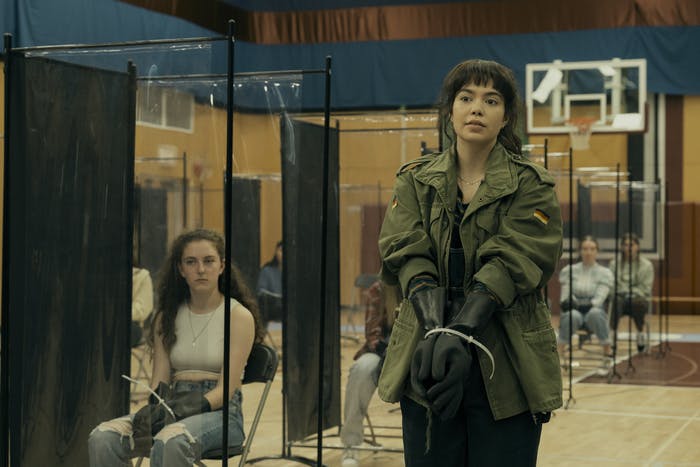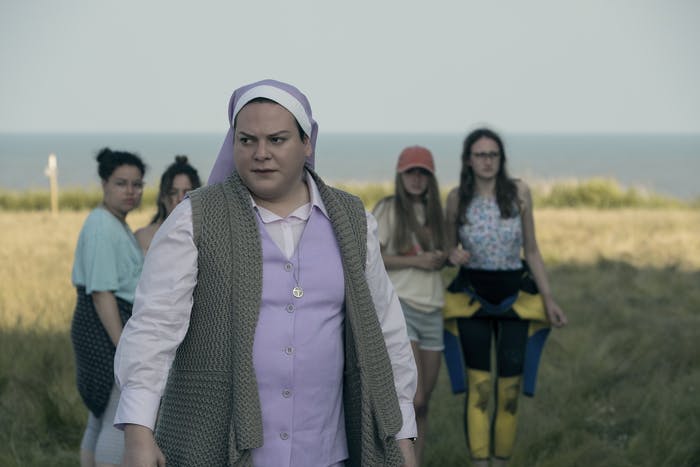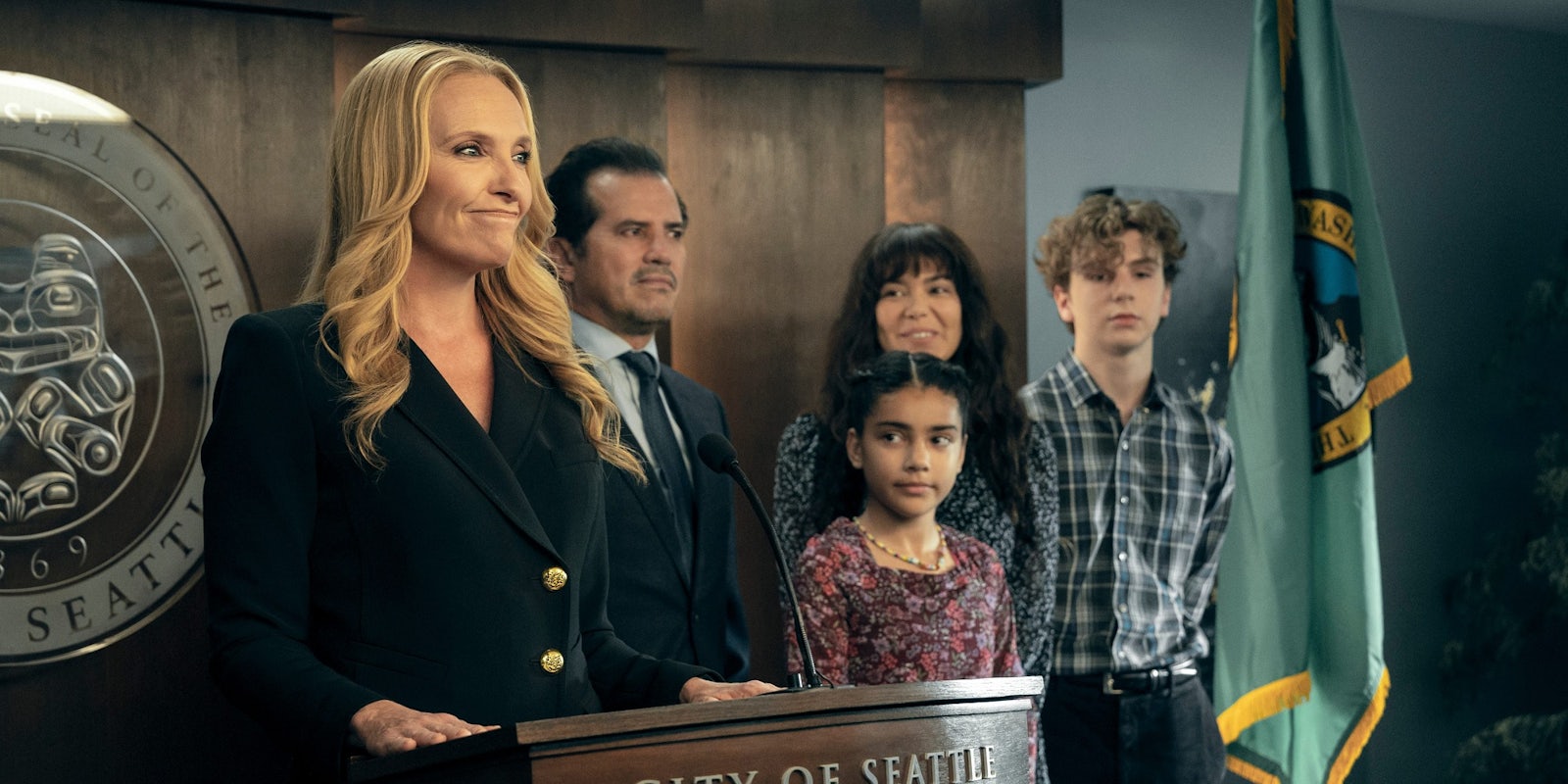Kicking off with a simple premise—teen girls everywhere develop lethal electro-shock superpowers—Amazon Prime’s The Power unfolds into a compelling speculative thriller. On a worldwide scale, it envisions a future where every woman has a built-in weapon, leading to massive sociopolitical upheaval. But a high-concept idea is nothing without conventional drama, and The Power also has that in spades.

Showrunner: Raelle Tucker
Streaming: Amazon Prime
Benefiting from excellent pacing and a compelling ensemble cast, this high-concept thriller is very watchable. However, its gender-based worldbuilding is pretty shaky in terms of trans and nonbinary representation; a familiar problem for speculative fiction about women overthrowing the patriarchy.
Toni Collette is the headline name of The Power‘s sprawling international cast, playing Seattle mayor Margot Cleary-Lopez, a political figurehead for girls and women developing this new power, known as EOD.
As a white feminist elected official, Margot’s viewpoint is explicitly influenced by struggles over abortion access and workplace discrimination, intersecting with conflicts within her own supporting cast: A sympathetic but underappreciated husband (John Leguizamo), an odious political opponent (Josh Charles), and her disgruntled teenage daughter (Auliʻi Cravalho), whose school descends into chaos as more girls develop EOD.
Elsewhere we meet a teenager with a more religious attitude to her new powers (Halle Bush), along with the angry, erratic daughter of a London gangster (Ria Zmitrowicz), and a Nigerian man (Ted Lasso’s Toheeb Jimoh) who accidentally becomes linked with a groundbreaking example of EOD.
In some ways reminiscent of a less-zany Sense8, this globetrotting structure juggles a diverse mix of genres and settings, smoothly introducing dozens of side characters. The one weak spot is a subplot about the trophy wife of an Eastern European dictator (Zrinka Cvitešić), entering a rather stereotypical territory compared to the realistic tone elsewhere.

Adapted from the novel by Naomi Alderman, The Power establishes EOD’s origins in medical terms, with plausible real-world repercussions: Surgical intervention, government registration, and ethically-dubious academic research.
Echoing other gender-based sci-fi stories like Y: The Last Man, the ensuing conflicts are a thought experiment about what would happen if our patriarchal systems were suddenly disrupted. And as we’ve seen in similar what-if narratives, this worldbuilding invites questions about trans inclusivity.
The Power and transgender representation
In the six episodes I watched for this review, the supporting cast included a trans woman and an intersex man, both with pretty simple roles. The show’s creators clearly want to acknowledge these perspectives, but the story is still rooted in a fairly binary view of sex and gender—including the divide between people who can develop EOD, and those who can’t.
EOD is positioned as a natural defense mechanism, redressing the power imbalance between men and women. Yet—and I’m trying to avoid spoilers here—if we follow The Power’s medicalized worldbuilding to its natural conclusion, then most trans women presumably don’t have EOD.
Meanwhile, many trans men would have EOD (whether they want it or not), and I suspect a lot of nonbinary people would have a difficult relationship with EOD’s symbolic role as a “female power,” generated by biological factors with no inherent relationship to identity.

So while The Power is thrilling and well-articulated in many ways, it still feels like the creative team is trying to have their cake and eat it too. This is a female empowerment narrative that simply can’t offer equal empowerment to people who aren’t cisgender, even if they also suffer under patriarchal rule.
Across the board, we see how EOD plays into pre-existing struggles for women’s rights: Politicians arguing over bodily autonomy, women killing their abusers and rapists, and teenage girls discovering a new sense of confidence.
Despite the negative consequences faced by its female protagonists (i.e. misogynist backlash; EOD-related accidents), a key appeal of The Power is seeing women fight back against oppression. And that’s obviously very satisfying! The show strikes a balance between wish fulfillment and nuanced political worldbuilding. But when it comes to gender inclusivity, the results are flawed, trying to avoid answering the question of what happens to all the trans, nonbinary, or intersex people we don’t see onscreen.
For instance, I can immediately guess how EOD would be leveraged to oppress trans people in my home country, the UK. Here, the majority of prominent female politicians and feminists are vocally transphobic, and anti-trans paranoia dominates the political discourse. So the sudden arrival of electrocution powers among “biologically female” people would surely exacerbate those problems.
Ultimately, this is a rather longwinded way of saying that while The Power has many fine qualities as a drama, it lacks a queer perspective on gender. Despite some cursory efforts to the contrary, its worldbuilding clashes with the idea of sex and gender as a spectrum.
Some viewers will find this issue an automatic turnoff, but in other regards, The Power has much to offer, both in terms of smart speculative storytelling and pure entertainment. Closer to the tight, character-focused thrills of something like Battlestar Galactica, it avoids the bloat of many Netflix-style streaming shows, making excellent use of its time—and ours.
The Power’s first three episodes premiere on Amazon Prime Video on March 31.



